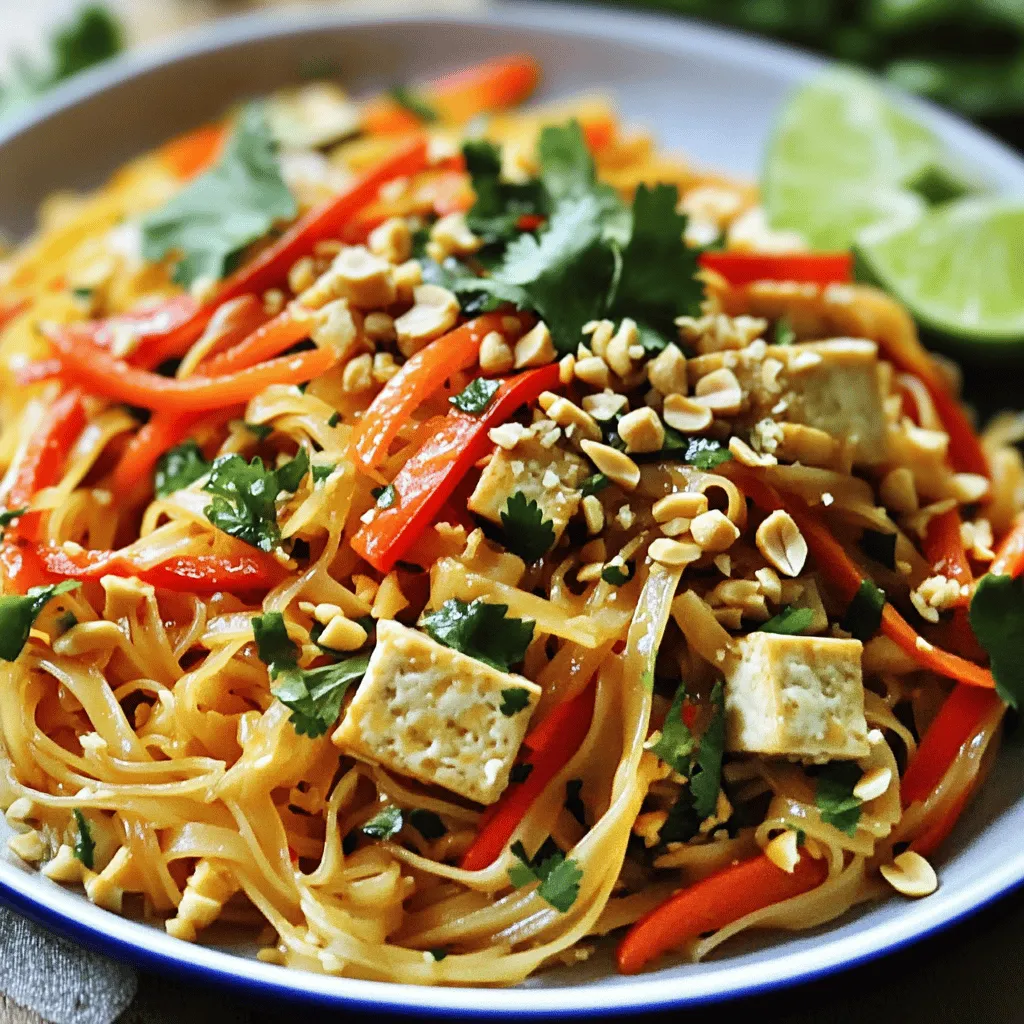Are you ready to transform your dinner routine? This Vegetable Pad Thai packs a punch of flavor and nutrition in every bite! With vibrant veggies, crispy tofu, and a rich sauce, it’s a delightful twist on a classic dish. Follow my step-by-step guide to whip up this tasty meal in no time. Let’s dive into the ingredients and cooking methods that make this recipe a winner on your table!
Ingredients
Main Ingredients for Vegetable Pad Thai
– 8 oz rice noodles
– 1 cup firm tofu, cubed
– 1 cup carrots, julienned
– 1 red bell pepper, thinly sliced
– 1 cup bean sprouts
To make a great Vegetable Pad Thai, you need a few key ingredients. Rice noodles serve as the base. They soak up flavors and give a nice chewy texture. Firm tofu adds protein and a good bite. Fresh vegetables like carrots and red bell pepper bring color and crunch. Finally, bean sprouts add a fun crunch and freshness to each bite.
Sauces and Seasonings
– 3 tablespoons soy sauce
– 1 tablespoon tamarind paste
– 1 tablespoon brown sugar
– 1 teaspoon chili powder
The sauces make the dish shine. Soy sauce adds saltiness and depth. Tamarind paste gives a unique tang that’s hard to resist. Brown sugar balances the flavors with sweetness. Adjust the chili powder to your spice level. You want a kick but not too much heat.
Optional Ingredients
– 2 eggs (for non-vegan version)
– 1/4 cup crushed peanuts
– Fresh cilantro for garnish
– Lime wedges for serving
For extra flavor, you can add eggs. They make the dish richer and heartier. Crushed peanuts not only give crunch but also add a nutty taste. Fresh cilantro brightens the dish and lime wedges add a zesty finish. These garnishes make your Vegetable Pad Thai look and taste amazing.
Step-by-Step Instructions
Preparing the Rice Noodles
Boiling the rice noodles is easy. Start by bringing a large pot of water to a boil. Add 8 oz of rice noodles and cook them for about 4-6 minutes. Check the package for exact times. Once cooked, drain the noodles and rinse them under cold water. This stops the cooking and helps prevent sticking. Set them aside for later.
Cooking the Tofu
Tofu adds great texture. Heat 2 tablespoons of vegetable oil in a large skillet over medium-high heat. Carefully add 1 cup of cubed firm tofu. Sauté the tofu for about 5-7 minutes. You want it golden brown and crispy on all sides. Once done, take the tofu out and keep it warm on a plate.
Stir-Frying Vegetables
Add flavor with garlic. In the same skillet, toss in 2 cloves of minced garlic. Sauté for 30 seconds until it smells good. Next, add 1 cup of julienned carrots and 1 thinly sliced red bell pepper. Stir-fry these for 3-4 minutes until they start to soften. You want them tender but still crunchy.
Combining Ingredients
Now, combine everything. Push the vegetables to one side of the skillet. If you are using eggs, pour in 2 lightly beaten eggs in the cleared space. Scramble them until fully set. Mix them together with the veggies. Then, add the cooked rice noodles and sautéed tofu back into the skillet.
Finishing with Bean Sprouts
For the final touch, add 1 cup of bean sprouts and half of the chopped green onions. Cook for another 1-2 minutes until everything is hot. This keeps the bean sprouts crunchy.
Serving Suggestions
When serving, make it pretty. Use a large, shallow bowl for the pad thai. Top each serving with crushed peanuts, the rest of the green onions, and fresh cilantro. Don’t forget lime wedges on the side for a zesty kick.
Tips & Tricks
Customization Options
You can easily customize your Vegetable Pad Thai. If you don’t like tofu, try other plant-based proteins like tempeh or seitan. These alternatives add different flavors and textures.
Feel free to swap out vegetables too. If you prefer broccoli or snap peas, add them! Use what you have on hand or what you love. This dish is all about flexibility.
Cooking Techniques for Better Texture
To avoid sticky noodles, rinse them under cold water after cooking. This step helps separate the noodles. You want them to be soft but not mushy.
Stir-frying requires high heat. Use a large skillet or wok to ensure even cooking. High heat helps all ingredients cook quickly and keeps them crisp. This way, you get the best texture and flavor.
Flavor Enhancements
Spice up your Pad Thai with fresh herbs like basil or mint. These add a nice pop of flavor. You can also use crushed red pepper for extra heat.
Pair flavors by serving lime wedges alongside your dish. The citrus brightens the taste. It also enhances the rich flavors of the sauce.

Variations
Vegan Vegetable Pad Thai
You can make a vegan version of Vegetable Pad Thai easily. Just skip the eggs. Instead, add more plant-based proteins like chickpeas or edamame. These options boost protein and taste. You still get a filling meal without eggs. Using tofu alone gives a nice texture but more protein is always better!
Gluten-Free Version
For a gluten-free Pad Thai, use rice noodles. They are naturally gluten-free and ideal for this dish. Also, choose gluten-free sauces, like tamari instead of soy sauce. Check labels to ensure all sauces are gluten-free. This way, you can enjoy this dish without worry. The flavor stays rich and satisfying!
Spicy Vegetable Pad Thai
If you love heat, make your Pad Thai spicy! Start by adding more chili powder to the sauce. You can also throw in fresh chilies for an extra kick. Adjust the spice level based on your taste. Remember, you can always add more heat, but it’s hard to take it away. Spice lovers will enjoy this version!
Storage Info
Refrigerating Leftovers
To keep your Vegetable Pad Thai fresh, cool it quickly. Spread it out in a shallow dish. This helps the heat escape fast. Once cooled, place it in an airtight container. Glass containers work well for storage. They keep flavors and are easy to clean.
Reheating Methods
When it’s time to eat your leftovers, choose the right method. The stovetop is best for reheating. It keeps the noodles from becoming mushy. Simply add a splash of water and stir until heated. If you use a microwave, heat in short bursts. Stir between sessions to avoid hot spots.
Shelf Life of Vegetable Pad Thai
In the fridge, your Vegetable Pad Thai lasts about three days. After that, check for spoilage. If it smells sour or has a slimy texture, it’s time to toss it. Always trust your senses to ensure safety. For the best taste, eat it within a day or two.
FAQs
What is the best type of noodles for Pad Thai?
The best noodles for Pad Thai are rice noodles. They are gluten-free and soak up flavors well. You can find them in various widths. You can also use flat rice noodles for a chewy texture. If you can’t find rice noodles, you can try using egg noodles. However, the taste will differ.
Can I make Pad Thai ahead of time?
Yes, you can make Pad Thai ahead of time. You can cook the noodles and store them separately. Keep the cooked noodles in a sealed container. Store the sauce and veggies in another container. When ready to eat, just combine them in a skillet. Heat everything until warm. This method keeps flavors fresh and bright.
How do I make Vegetable Pad Thai spicier?
To make your Vegetable Pad Thai spicier, add more chili powder. You can also use fresh chilies like Thai bird’s eye chilies. Start with a small amount and taste as you go. For more heat, try adding sriracha or sambal oelek. These sauces add both heat and flavor.
What is tamarind paste, and where can I find it?
Tamarind paste is a thick, dark paste from tamarind fruit. It has a sour and sweet flavor. This flavor adds depth to Pad Thai. You can find tamarind paste in Asian markets or online. It often comes in jars or blocks.
Is this Vegetable Pad Thai suitable for meal prep?
Yes, this Vegetable Pad Thai is great for meal prep. You can chop veggies in advance and store them in the fridge. Cooked noodles can also be made ahead and stored separately. Just mix everything together before serving. This keeps your meal fresh and tasty.
Can I omit tofu from the recipe?
Yes, you can omit tofu from the recipe. If you want protein, consider using chickpeas or tempeh. You can also add more vegetables like mushrooms or zucchini. This keeps it filling and nutritious.
You learned about making Vegetable Pad Thai, focusing on key ingredients and process. From rice noodles to crisp tofu and vibrant veggies, each part is important. Customize your dish with tips on spices and substitutions. Remember, it’s easy to adapt this recipe to suit your taste. Enjoy your meal and explore different variations. With a little practice, you’ll master this tasty dish and impress your friends. Happy cooking!


